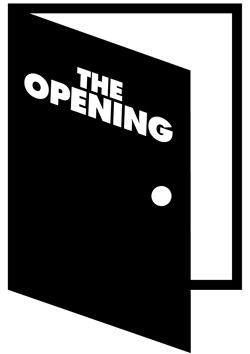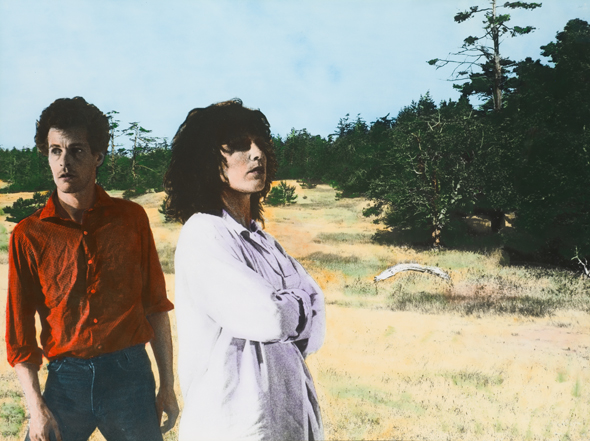 |
THE OPENING is all about delving into the fascinating, quirky and wonderful visual arts in Vancouver. Each week we’ll feature an artist, cover an exhibition, discuss a lecture and everything else in-between to delve deep into who and what makes art happen! |
If some alarmist art critics are to be believed, painting is dead. Still others claim photography is dead. Thankfully no one is actually listening, least of all Vancouver-based artist Ian Wallace, a large portion of whose body of work is currently on display in Ian Wallace: At the Intersection of Painting and Photography at the Vancouver Art Gallery until February 24, 2013.

'Lookout', 1979 (detail), 12 hand-colour silver gelatin prints. Collection of the Vancouver Art Gallery, Vancouver Art Gallery Acquisition Fund. Photo: Tomas Svab, Vancouver Art Gallery.
Wallace is a very influential figure in the Vancouver visual arts community, having taught a number of now well-known artists at either the University of British Columbia or the Vancouver School of Art (now Emily Carr University). Not only were people like Jeff Wall, Rodney Graham and Ken Lum students under Wallace, but many became friends and peers. Wallace, Graham and Wall at one point played in a punk band together called U-J3RK5 (pronounced "you jerk") with Kitty Byrne, Colin Griffiths, Danice McLeod, Frank Ramirez and David Wisdom. Many of Wallace's works feature these and other notable members of Vancouver's cultural community as his models, from Lookout in 1979 right up to the new versions of At The Crosswalk from 2011, commissioned specifically for this exhibition.

'My Heroes in the Street II', 1986, photolaminate, acrylic on canvas 183 x 336 cm, Collection of the Art Gallery of Ontario, Toronto. Gift of Ydessa Hendeles, 2009. Photo: Trevor Mills, Vancouver Art Gallery.

'Intersection (Place Sartre-Beauvoir, Paris)', 2006, photolaminate, acrylic on canvas 152 x 122 cm. Collection of Ian Gillespie. Photo: Trevor Mills, Vancouver Art Gallery.
The exhibition itself is a comprehensive look at Wallace's 40 plus years of artistic output, with 220 works divided thematically into five sections between two floors of the gallery. Curated by Chief Curator/ Associate Director Daina Augaitis with assistance from Associate Curator Kathleen Ritter, Intersection was four years in the making with deep input and assistance from Wallace himself. While his work is visually stunning and alone worth appreciating for that reason, it is also very conceptual, filled with symbolism and meaning that can easily be lost in this massive exhibition. Those who feel they know everything there is to know about art (seriously?!) will scoff at me, but in this instance I highly recommend taking one of the free with admission tours the VAG offers every Thursday and Sunday (schedule and info here). Augaitis and Ritter will also be leading a tour this coming Saturday, November 10th at 2pm (again, free with gallery admission).

'Clayoquot Protest (August 9, 1993) I-IX', 1993-95 (detail), photolaminate, ink monoprint, acrylic on canvas, 9 panels. Collection of the Vancouver Art Gallery, Gift of the Artist. Photo: Trevor Mills, Vancouver Art Gallery.
The five themes, in order of appearance are the cinematic, the literary, the street, the museum and the studio. The cinematic is a great way to open the exhibition, as Wallace is adept at capturing a narrative simply and forcefully. The most powerful work in the section is the well-known Clayoquot Protest (August 9, 1993) I-IX from 1993-95. It depicts thousands of people peacefully protesting to protect the temperate rainforest area of Clayoquot Sound from the threat of logging, a protest which resulted in the largest mass arrest in Canadian history (900 people - see this Common Ground article for more information). Wallace's panels, which surround you in a small, purpose built exhibition room, combine painted plywood with highly detailed blow up photographs of the protest. Entering the room, you are enveloped by a sense of calm and also one of passion and purpose - every single person photographed that day was there for an important reason, and that feeling emanates throughout the room. Wallace's photographs are often staged and his subjects are often aware they are modelling for him, but that's not the case for these. He had been heavily focused on studio work in the previous years and felt he needed to do a major work focused on society as a whole and what was going on in current history. So he captured a major moment in West Coast environmental protest history and created these stunning, huge panels. He likens them to "photojournalism translated in terms of the monumentality of history painting, of high art." A modern, peaceful take on the often violent works of the past.

'Untitled (Red Monochrome with Yellow)', 1967/2009, acrylic on canvas 229 x 51 cm. Courtesy of the artist. Photo: Rachel Topham, Vancouver Art Gallery.
Scattered throughout the exhibition are 30 versions of Wallace's long, vertical monochromes. The monochrome is an important and recurring theme throughout all of his art, so these behave as both interventions and reminders of the over-arching themes of his work between the exhibition's themes itself. Each monochrome has a primary colour that takes up most of the canvas in the centre, and is then framed by one of its complimentary colours. Wallace has been using monochrome painting in many of his works as part of a greater reference to modernity. As he eloquently puts it in his essay as a part of the accompanying exhibition catalogue:
I bring together in a single framed space the two antipodes of pictorial media of the modern period: painting that has been reduced to pure material, and photography which is unavoidably and purely representational; painting on canvas which is implicitly aesthetic, and photography which might or might not be aesthetic.

'Chambre 19 Hotel Rivoli, Paris', 2006, photolaminate, acrylic on canvas 121 x 121 cm. Collection of Harry and Ann Malcolmson. Photo: Rachel Topham, Vancouver Art Gallery.
The studio has been a place of great work and reflection for Wallace, and his works around this important artistic space provide inevitable insight into his process. The studio section is actually the last section in the exhibition, with a great portion of it dedicated to his seminal work At Work. All that said, the studio works that had a greater impact for me are featured earlier in the section related to text. While the themes of the exhibition act as a guideline for viewing of the exhibit, as you can well imagine a number of his works fit into multiple themes. Although the studio section is fantastic, featuring both his earliest exhibited work to a work completed only a week before the exhibition opened, I was most drawn to the works on his time in hotels (in this case, in Paris), where the studio was actually on the road, placed in the text section. For a lot of artists, the idea of taking the studio on the road, much less to a tiny European hotel room, is not often thought of when the final work produced is so large. But for Wallace, whose work is often just as much about the thought as it is about the work, the studio is a fluid space that can be almost anywhere. The Paris hotel panels display numerous layers of the works themselves - he created maquettes of the works in the hotel room, which he then photographed and pasted on the panels. It's almost like those repeating mirror works where the scene just goes on and on, but not quite. For work that seems so deeply conceptual, it's a nice thought - that art can be produced anywhere and (with a little thought behind it) be from anything.

'La Melancolie de la rue', 1973, 3 hand-coloured silver gelatin prints 103 x 469.5 (overall). Collection of the Vancouver Art Gallery, Vancouver Art Gallery Acquisition Fund. Photo: Trevor Mills, Vancouver Art Gallery.
Ian Wallace: At the Intersection of Painting and Photography should not be missed. As a pictoral and theoretical history of the visual arts in Vancouver, Wallace's work provides the context for so much of what is produced in Vancouver today, whether those artists know it or not. When Chief Curator Daina Augautis graduated from Emily Carr's (now non-existent) curatorial program in 1983 where Wallace was her instructor, "he coached me to not only search out the new and the bold, but to consider also all those who have paved the way." His work should be considered not only for paving the way for conceptual contemporary art in Vancouver, but for providing enrichment to so many generations of artists and art-lovers.
All images courtesy Vancouver Art Gallery.


